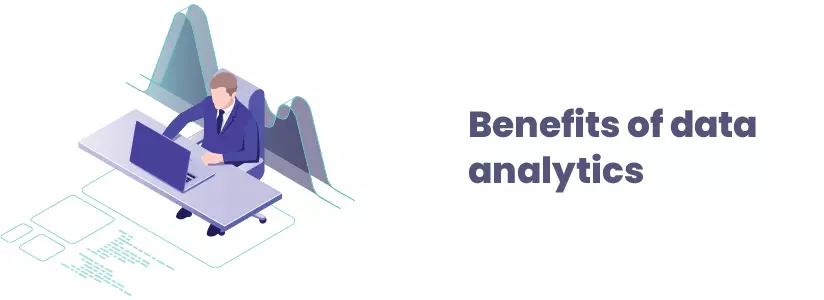Why Data Analytics Solutions Should Be The New Trend SMBs Catch Up On

Here is an interesting fact – today, humans produce 2.5 quintillion bytes of data every day. How much do you think it is? It’s 2.5, followed by 18 zeros! Mind-bending right?
We live in the technological era. The number of people with access to a phone right now is staggering. And everybody’s surfing over the internet on Google, Facebook, Twitter, Instagram, ecommerce websites, and everything else you can think of. All such online activities generate astronomical data, which companies leverage to make boardroom business decisions.
Along with data analytics, artificial intelligence has been creating a buzz in the tech industry. Big businesses have been using data analytics to uncover insights for more significant revenue-generating opportunities. DA and AI are the new kid on the block, and companies have claimed their fair share of both.
According to experts, more businesses are hopping on the data analytics trend and exploring it in their own way. The biggest motivator for companies to try out data analytics is the fear of becoming irrelevant. Afterall being in business is the top priority for playing the game.
The data analytics solutions can analyze large volumes of data quickly and accurately. Humans tend to miss out on things even with the perfect software. But data analytics software is something you can trust to handle data coming from all sources. It is now more than just an IT fad. A widely accepted and implemented technology that you can’t afford to miss out on. If your enterprise is still waiting to deploy the technology, it might have a lot to catch up to with the rest of the industry.
Also Read: Revolutionize Your Business Operations With Microsoft Power BI
What Is Big Data Analytics?
At this point, you might have a good hunch of what is big data analytics but let’s go through it for better clarity. In simplest terms, big data analytics is the accumulation, processing, and analysis of large sets of data.
While it might sound new, the concept of big data analytics has been around for a long time. Its importance, however, has been recently captured by most organizations. They now comprehend that if they gather all the data are coming about the business, they can analyze it for illuminating insights.
From spreadsheets to highly evolved dashboards, data analytics has always been a part of running a business effectively. But data analytics bring more to the table than just numbers and market trends. The newer tech has made it far more speedy and efficient to assess data. Now, it’s possible to create a report of the sales in just a few clicks. Decisions can be made in an instant, depending on data.
Data analytics has made doing business faster and more adaptable to changing trends, giving organizations an edge over competitors. To achieve optimum results, partnering with the best Power BI development company is crucial.
Also Read: Tableau Vs Power BI: Which Data Visualization Tool Is Better For Your Business
How Does Data Analytics Work?
1. Data collection
The first step is to gather data from all the sources. The sources today can include:
- Mobile applications
- Website clickstream data
- Social media content
- Ads click-through data
- Server logs
- Emails, texts, and responses from customers
- Customer care phone records
- Reviews and ratings
The data captured from all the different sources is unrefined and unstructured. Organizations employ data analysts, data scientists, statisticians, and others to modify this data for further analysis. And that’s step two.
2. Data processing
All the data collected is stored on company servers or data warehouses where professionals polish, optimize and organize data for analytical business issues.
3. Data cleansing
Not all bits of big data are helpful; it has to be cleaned for thorough data analysis. Data analysts use tools to refine the data for enterprise use. They look out for any anomalies, duplicate data, and format it.
4. Data analysis
The refined data is analyzed using tools and software for specific purposes. There are many tools for statistical analysis, data mining, text mining, predictive analysis, and more. AIML software and data visualization tools are used to represent data in a readable format.
Also Read: Why Do People Prefer Microsoft’s Power BI over Other Data Visualization Tools?
Uses Of Data Analytics

Businesses generate a variety of data that contains valuable insights, and data analytics discovers them. The applications of data analytics are numerous for organizations. Let’s discuss some of them.
1. Customer acquisition
A major part of the marketing budget expense is for acquiring new customers in the den. With the help of consumer data, their preferences, the product they buy most and other details, companies can increase customer satisfaction.
The aptest example is personalization. For ecommerce companies, OTT platforms, and other businesses with customer profiles, personalization is vital to improve customer experience and increase customer loyalty. All the personalization engines work on data analysis about customer behavior and display the most relevant results in search.
2. Targeted ads
This is an extension of personalization use. Users spend a significant amount of time on screen, and the most smooth experience killer is ads. But through data analysis of previous purchases, buying patterns, and the product pages visited, more personalized ads can be generated. This will keep the users engaged and increase the effectiveness of ad campaigns on a large scale.
3. Faster decision making
Our world moves fast, and businesses need to act faster to keep up. With the ability to analyze any new information speedily, companies increase the quality of decisions. Using Hadoop analytics, new information processing is increased, and businesses can make better decisions in a much shorter timeline.
4. Product and services development
Big data analytics comes in handy, whether it’s for launching new products or updating the older ones to match customer needs. Data analytics help businesses deep dive into what customers are looking for. Using the reports, businesses can update their existing products and services with viable measures and launch new ones to satisfy the customer’s needs.
5. Operations management
Looking over the entire operations of a business becomes easy with data analytics. Collecting and analyzing data about all the deliveries and timelines can predict where future delays might occur. This is especially good for retail businesses where the correct supply and demand analysis is crucial to meet the required quota on time.
For instance, the data analytics system will tell you whether a particular manufacturer will be able to produce the holiday season supply or not. So you can reassign the shipment to others and avoid any delays.
6. Mitigating risks
Analyzing the data patterns, it becomes to predict any risks in business. It can help businesses deploy preventive measures for employee theft, safety, pending bills, and legal obligations.
Also Read: How Power BI Consulting can take your Business to Next Level?
Benefits of Data Analytics

- Speed is the prime benefit of data analytics. One can quickly analyze massive volumes of data from multiple sources, formats, and styles in a much shorter time.
- Help board members make an informed decision with hidden insights and enhanced strategies.
- Better insights into customer feelings and needs along with product performance findings
- Streamlining operations, supply chain management, and handling other departments of business too.
- Product pricing and personalization for customers for maximizing revenue
- Cost savings from business operations optimizations
- Better risk management strategies
Data Analytics: The Future Of Running Businesses
A broader category of enterprises is diving into the world of data to gain an advantage over competitors. And this new technology is continuously evolving to cater to companies’ needs. Don’t miss out on the data analytics software and risk losing your customers in the future.
Contact our Power BI consultants for more information about data analytics software and its benefits for your business. Also have a look at our Portfolio here!
Similar Posts

Expert Solutions for Power BI Consulting Firm: Advanced Data Analytics
Businesses depend closely on their ability to accumulate, system, and interpret statistics in contemporary global data-based systems. Data analytics offers crucial insights into client behavior, operational efficiency, and market traits. One of the main systems for remodeling raw information into actionable insights is Power BI. Whether you’re a small startup or a huge company, utilizing […]...

Transform Your Business Operations with Microsoft Power BI
Back in the 1970s, companies had to handle a lot of paperwork for every department. But with the invention of the computer, now in 2021, everything is digital. Because of the revolutionizing technology of computers, there is minimal paperwork and hard copies of business records....

Power BI for the Enterprise: A Complete Guide to Business Success
As businesses flow at a rapid tempo these days, data is king. Companies are constantly on the watchout for ways to higher understanding of their operations, clients, and the market. This is the area where Power BI for the Enterprise comes in. We can say it’s not only visualizing data; it makes a complete platform […]...











